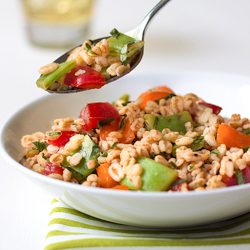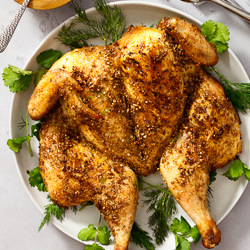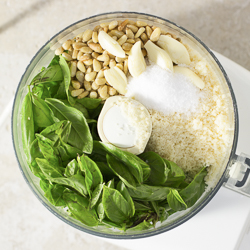It seems like it should be so simple, how to cook rice. As basic as boiling water, no? But mine never came out quite right. (I blame my parents—we weren’t a rice family.)
I tried all the can’t-miss methods. Two parts water to one part rice. One-and-a-half parts water to one part rice. The one where you use the knuckle of your finger to determine the ratio of water to rice. Even the method where you go out and buy a rice cooker to do it for you.
But I kept ending up with rice that was either mushy or rice that was dry and stuck to the bottom of the saucepan.
That is, until I learned “the Kate method” from, of course, my friend Kate.
It was when we were cooking together at my café, over twenty-ahem years ago. She was a vegetarian, which in my mind gave her credibility in the rice department. So when yet-another pot of imperfect rice inspired her to relay a tip, I listened.
She said to use slightly less than two parts water to one part rice.
That’s it. Slightly less than two parts water to one part rice. And it works every time. Long grain, short grain, white rice, brown rice.
What’s slightly less than two parts water? For a café-sized 6-cup batch of rice, that meant about 11 1/2 cups of water. For a home-sized 1-cup batch of rice, that means about 1 7/8 cups of water. For something in between, say 2 1/2 cups of rice, that means about 4 3/4 cups of water.
Over the years, I’ve added other bits to my rice-making technique, but have never strayed from Kate’s ratio.
So then, here’s how to cook rice:
1. Rinse, or not.
Most recommend rinsing rice before cooking it, but I confess that I usually don’t bother. Rinsing washes away any starch around the individual grains, making your finished rice less sticky. But most of the time when I’m making rice, I’m serving it with stir-fry—the Cashew Chicken Stir-Fry pictured in this post, for example—and I like sticky-ish rice for stir-fry.
If you, however, prefer not-sticky rice, just put it in a strainer and run water over it until the water comes out relatively clear. Then give it a couple of shakes to get rid of excess water before proceeding.
2. Place the rice in a saucepan with a decent-fitting lid and add a little less than twice the water.
For example, for 1 cup of rice, use about 1 7/8 cups water. For 2 or 2 1/2 cups of rice, use about 3 3/4 cups of water.
What size saucepan? I like one that’s relatively deep compared to the amount of rice and water—so the water is less likely bubble up and boil over.
3. If you like, add a pinch of salt.
4. Bring the water to a boil over medium-high heat, then cover the pot and put the heat on the lowest setting you can.
5. After about 15 minutes, maybe a little longer for brown rice, check for doneness.
Remove the lid and look for air vents—your rice should look like it’s been repeatedly poked with a skewer or chopstick.
If there are air vents, then tip the saucepan about 60 degrees. If no water appears over the rim of the rice, it’s done.
6. Set it aside.
Remove your rice from the heat and let it rest, covered, for about 5 minutes. This will help the rice have a more uniform texture, avoiding some grains that are more wet and mushy and others that are more dry.
Note, though, that you can let it rest for up to an hour or more. With the lid on, it’ll stay plenty warm and serveable. This is good news because it means you never have to worry about timing rice so it’s done at exactly the same time as the rest of your meal. Make it early and it’ll patiently stand by until you’re ready for it!
7. Serve.
With Cashew Chicken Stir-Fry perhaps. :)
After all this time, even when my husband cooks rice he’ll ask, “Remind me, what’s the Kate method?” And with each pot, along with perfect rice, I get to spend a mental moment cooking with Kate again.











